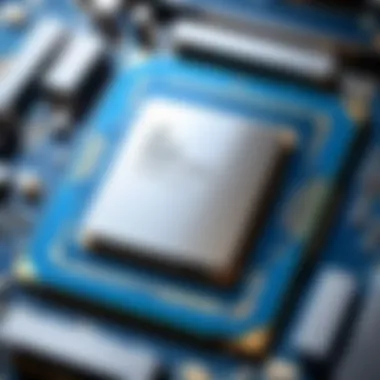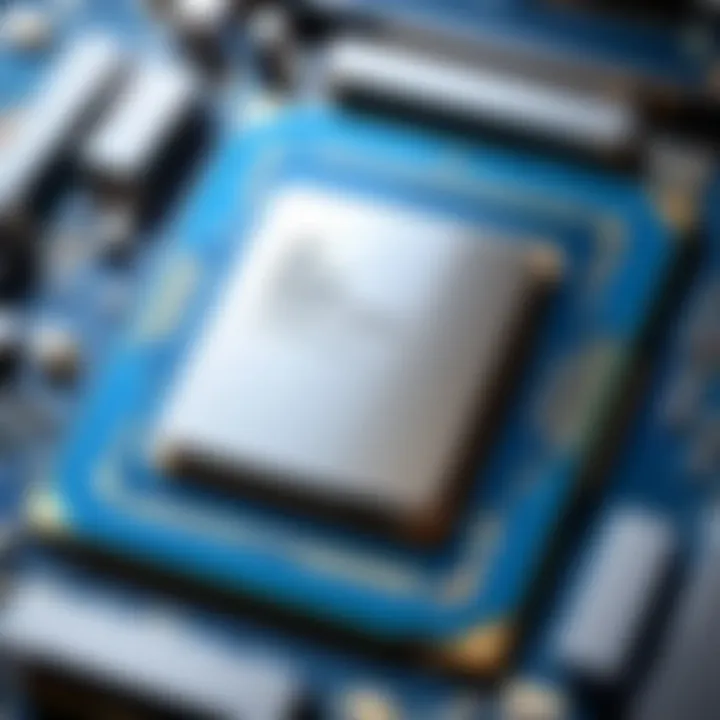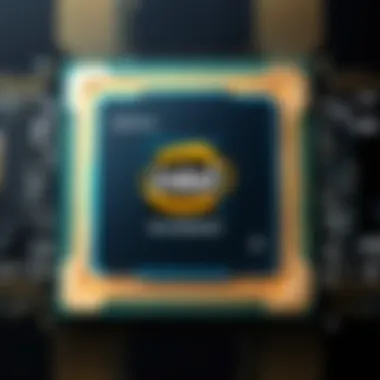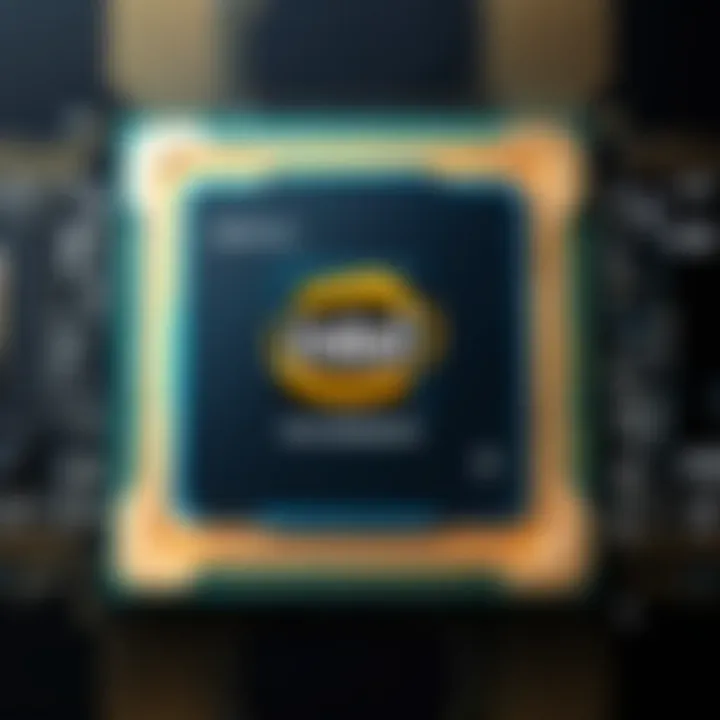Intel's 13th Generation CPU: An In-Depth Analysis


Intro
Intel's 13th Generation CPU has made waves in the computing industry, representing a significant leap in performance and efficiency. As technology progresses at a rapid pace, understanding the features and capabilities of this generation is vital for IT professionals and tech enthusiasts alike. This article aims to provide a comprehensive analysis of Intel's latest offering, examining its architecture, performance benchmarks, and broader implications for hardware and software optimization.
As we explore the technical specifications, it is essential to highlight how these advancements might affect existing systems. Furthermore, we will assess the overall compatibility of the CPU with various software applications and hardware components, ensuring readers can make informed decisions when upgrading their systems.
This in-depth analysis also touches on how the 13th Generation CPU positions itself in the market compared to previous iterations, presenting a clear understanding of its unique selling points. With this context set, let's delve into the first section: Features Overview.
Intro to Intel's 13th Generation CPU
The launch of Intel's 13th Generation CPU marks a pivotal moment in the world of processing technology. It symbolizes a significant leap forward, integrating new architectural innovations and performance enhancements that cater to the needs of both IT professionals and tech enthusiasts. This generation provides a systematic upgrade over its predecessors, enabling better efficiency and higher processing power.
In the landscape of computing, the performance of a CPU determines the entire system's capability. Users require reliable and powerful processors to handle complex tasks, whether they are performing data analysis, running simulations, or engaging in high-performance gaming. Intel's 13th Generation aims to fulfill these demands, offering features that enhance speed and responsiveness while optimizing power consumption.
Key elements of the 13th Generation CPU include advanced multi-threading capabilities, which allow for improved handling of workflows that utilize numerous software threads simultaneously. This is particularly relevant in environments where multitasking is paramount.
Furthermore, the changes in the manufacturing process contribute to reduced thermal output, addressing long-standing efficiency concerns.
The combination of performance and efficiency ensures that users can tap into maximum computing potential without compromising on stability.
As we explore the various aspects of Intel's 13th Generation, we will also assess its compatibility with existing hardware and software frameworks. This analysis will provide insights into how the new CPU interacts with diverse systems, which is critical for an optimized setup. Additionally, we will delve into market positioning, comparing its specifications and features with those of previous generations. The discussion will illuminate the trajectory of CPU technology and its effects on the future of computing.
Understanding the Intel 13th Generation CPU is essential for making informed decisions regarding current infrastructures or upcoming builds. By examining the architecture, metrics, and compatibility, users can derive substantial benefits, accelerating performance to meet the challenges posed by modern computing demands.
Architectural Innovations
Architectural innovations serve as the backbone of any generation of CPU. In the case of Intel’s 13th Generation, these innovations are not merely incremental improvements; they mark a distinct evolution of processing capabilities. This section delves into the architectural changes that contribute significantly to performance, power efficiency, and overall system compatibility.
Overview of Microarchitecture
The microarchitecture of the 13th Generation Intel CPU is a crucial aspect that determines its overall efficiency and performance. It integrates a combination of designed cores, cache levels, and memory pathways distinctly optimized for processing tasks.
Intel's hybrid architecture continues to be a defining feature, with a mix of Performance-cores (P-cores) and Efficient-cores (E-cores).
- P-cores aim at optimal single-thread performance.
- E-cores focus on efficiency, managing tasks that do not require high performance.
This architecture allows the 13th Generation CPUs to intelligently allocate resources depending on workload requirements. Furthermore, the ability to scale up or down leads to effective power management while maintaining high throughput. This microarchitectural setup plays a significant role in improving multi-threaded performance, as hybrid workloads become increasingly common in both commercial and consumer sectors.
Manufacturing Process
The manufacturing process of the Intel 13th Generation CPU incorporates cutting-edge techniques that herald improvements over its predecessors. Utilizing the Intel 7 process, which is a refined version of the 10nm SuperFin technology, allows for denser transistor placement, boosting performance and minimizing energy waste.
Precision in the lithography process has increased, leading to
- Enhanced transistor performance
- Greater thermal efficiency
This advancement is crucial because reduced size leads to better performance-per-watt ratios. The smaller dimensions mean more transistors can fit on a single chip, which directly correlates with processing power. Moreover, adopting advanced packaging techniques like Foveros can facilitate integrated chip designs. These methods pave the way for significant advancements in cooling and overall energy consumption.
New Technologies Implemented
Intel’s 13th Generation CPU introduces several new technologies that address both current demands and future needs. Key technological advancements include:
- DDR5 Memory Support: This provides a marked increase in memory bandwidth and performance. Using DDR5 enhances data transfer speed while simultaneously lowering power consumption.
- PCIe 5.0 Interface: The introduction of PCIe 5.0 provides double the data bandwidth compared to its predecessor. This is crucial for high-speed devices like GPUs and NVMe SSDs, ensuring seamless performance improvement in gaming and computational tasks.
- Intel Thread Director: This technology optimizes core workload management in real time, ensuring that applications run on the appropriate cores. This results in improved efficiency and responsiveness for demanding tasks.
These innovations not only enhance the operational capacity of the CPUs but also create a strong foundation for future system designs, allowing IT professionals and enthusiasts to make informed decisions regarding hardware upgrades and new builds.
"Architectural choices have a lasting impact on CPU performance, extendibility, and market perception."
In summary, the architectural innovations within Intel's 13th Generation CPU are pivotal for improving computational capabilities and energy efficiency. This foundation significantly influences how systems are built and optimized for various applications, signaling a new era in CPU design.


Performance Metrics
Performance metrics are critical in assessing the capabilities of any CPU. In the context of Intel's 13th Generation CPU, these metrics provide insights into how the processor performs under various workloads. Understanding these metrics allows IT professionals to make informed decisions about system upgrades and optimizations. Key performance elements include single-core and multi-core performance, which are vital for different applications ranging from gaming to heavy computational tasks.
Performance metrics help in identifying bottlenecks and optimizing system resource allocation. They can indicate whether a CPU is suitable for specific applications, which is essential for engineers and developers. Evaluating performance leads to better overall efficiency, potentially reducing costs associated with hardware overhauls.
Single-Core Performance Analysis
Single-core performance remains a pivotal aspect of CPU functionality. Many tasks, especially those related to gaming and certain desktop applications, still rely heavily on single-threaded performance. The 13th Generation CPUs have advanced single-core capabilities, allowing them to handle tasks more swiftly and efficiently. Higher clock speeds and improved IPC (Instructions Per Cycle) contribute to this performance boost.
Performance benchmarks show that Intel's latest processors can outperform previous generations significantly. This improvement translates into shorter wait times and overall snappier system responses. Moreover, with the gaming industry continually pushing for higher frame rates and better graphics fidelity, strong single-core performance is paramount.
Multi-Core Performance Insights
Multi-core performance is equally important, as many modern applications can leverage multiple threads to maximize efficiency. Intel's 13th Generation CPUs include enhancements that allow better workload distribution across cores. This results in improved performance in tasks such as video rendering, 3D modeling, and software development.
The new architecture supports more cores and threads, which provides a competitive edge. Users engaged in multimedia content creation or software development will notice considerable gains. Furthermore, this improvement affects multitasking capabilities, enabling users to run multiple applications without a significant drop in responsiveness.
Benchmark Comparisons with Previous Generations
Benchmark comparisons are essential for understanding the generational leap in performance. When compared with Intel's 12th Generation CPUs, the 13th Generation shows marked improvements in both single and multi-core scenarios. Synthetic benchmarks, such as Cinebench and Geekbench, consistently place the new generation ahead in both single-threaded and multi-threaded tests.
Real-world applications also demonstrate this advantage. Tasks like file compression, database management, and gaming performance have improved. Users should consider these benchmarks when evaluating their current systems and deciding on upgrades.
Thermal Design and Efficiency
Thermal design and efficiency are crucial elements in the performance and longevity of Intel's 13th Generation CPU. As processors become more powerful, they generate more heat, which requires effective management to prevent thermal throttling. Proper thermal management ensures that the CPU operates within optimal temperature ranges, thus maintaining performance levels and protecting the hardware from damage due to overheating.
Additionally, efficiency in thermal design can lead to lower power consumption, which is beneficial for both mobile and desktop systems. This is particularly significant in an era where energy efficiency is a priority for consumers and businesses alike.
Thermal Management Solutions
Intel's 13th Generation CPU incorporates several innovative thermal management solutions designed to enhance cooling efficiency. One notable feature is the use of advanced heat spreaders and heat sinks that efficiently dissipate heat away from critical components. The materials used in these thermal solutions are carefully selected for their thermal conductivity, ensuring optimal heat transfer.
Another solution is the integration of intelligent thermal management technologies that dynamically adjust performance based on temperature readings. This adaptiveness allows the CPU to optimize its clock speeds and voltage levels, reducing energy consumption and heat generation during less intensive tasks.
- Improved airflow design: Some 13th Generation chips come with redesigned die layouts that foster better airflow within the system.
- Customizable fan profiles: Users can adjust fan speeds based on workload demands, allowing for performance tuning based on user needs.
These advancements signify a deliberate push towards mitigating thermal issues, ensuring the CPU can sustain high performance without compromising reliability.
Power Consumption Analysis
Power consumption is a vital metric to consider. Intel's 13th Generation CPUs have made strides in enhancing energy efficiency while boosting performance. With the introduction of the new architecture, the CPUs also employ dynamic frequency scaling that adapts power according to workload demands.
When comparing power efficiency to previous generations, the 13th Generation shows a noticeable improvement.
- Reduced idle power draw: This generation actively lowers power usage during idle states, contributing to overall energy savings.
- Performance per watt: The CPUs deliver more computational power for every watt consumed, which is critical for workflows that demand extensive processing capacity without excessive energy costs.
Noteworthy, the combination of advanced fabrication techniques and architectural enhancements has positioned Intel's 13th Generation CPUs to stand out in both power efficiency and thermal management.
In summary, thermal design and efficiency are not just technical specifications; they directly influence system performance, longevity, and energy consumption. For IT professionals evaluating systems based on powered devices, understanding these elements is paramount.
System Compatibility
System compatibility plays a crucial role in determining how effectively Intel's 13th Generation CPU can be integrated into existing computing systems. As technology progresses, it is essential to ensure that new hardware components can work seamlessly with older systems and vice versa. This compatibility not only affects performance but also influences the overall user experience. A CPU that lacks compatibility with current chipsets, motherboards, RAM, and graphics components could hinder potential advancements that the new architecture offers. Therefore, examining system compatibility provides IT professionals and tech enthusiasts a guideline to maximize the benefits of their new hardware while maintaining stability and performance.
Supported Chipsets and Motherboards
Intel's 13th Generation CPU is designed to work with a specific set of chipsets and motherboards to ensure optimal performance. The primary chipsets for this generation include Z790 and B760. These chipsets offer unique features that enhance the CPU performance, such as increased PCIe lanes and advanced memory support. By using motherboards with these chipsets, users can unlock the full potential of the new CPU, allowing better overclocking capabilities and improved memory speeds.
When selecting a motherboard, it’s important to also pay attention to the form factor. Users must choose between ATX, Micro-ATX, and Mini-ITX designs depending on their case limitations. Additionally, users must consider the number of expansion slots available, as this affects future upgrades such as graphics cards or additional storage.


RAM Compatibility and Performance
Intel’s 13th Generation CPUs support DDR5 RAM, which provides significant speed and bandwidth improvements over the previous DDR4 standard. This generation fully utilizes the capabilities of DDR5 synchronized memory to enhance performance for both single-core and multi-core workloads. However, RAM compatibility remains a consideration. Not all motherboards support DDR5, so users with older systems may find themselves needing to purchase new RAM, in addition to a compatible motherboard.
When considering RAM, speed is not the only factor. Timings and capability must also be evaluated because they influence how effectively memory can interact with the CPU. Recommended RAM speeds for optimal performance hover around 4800 MHz or higher, cutting the gap down by at least one generation.
Graphics Compatibility Overview
Another vital factor of system compatibility is the interaction between the Intel 13th Generation CPU and graphics cards. The CPU supports PCIe 5.0, the latest standard that doubles the bandwidth over PCIe 4.0. This increase allows for improved data flow between the CPU and graphics cards. It is important for users to ensure that their GPUs are compatible with PCIe 5.0 to leverage these benefits fully. Many of the contemporary graphics cards from NVIDIA and AMD now support this standard, allowing for a substantial performance boost in gaming and rendering tasks.
Ensuring compatibility with graphics components is key to maximizing the system performance. The cost of an upgrade could be dwarfed by the performance returns with proper alignments of hardware.
Software Optimization
Software optimization is a critical aspect of leveraging the capabilities offered by Intel's 13th Generation CPU. As processors become more advanced and integrated into diverse systems, ensuring that software can effectively utilize hardware resources becomes paramount. Optimization leads to enhanced performance, reduced latency, and improved overall user experience.
Operating System Compatibility
The compatibility of an operating system plays a significant role in maximizing the performance of the Intel 13th Generation CPU. Many operating systems are designed to take advantage of the latest hardware features, such as enhanced multi-threading and power management capabilities. Windows 11 and several Linux distributions, for example, have been updated to support the new architecture effectively.
Factors to consider include:
- Kernel optimizations: Updated kernels can exploit CPU features efficiently, improving task management and allocation.
- Resource management: Operating systems must manage CPU resources dynamically to avoid bottlenecks.
- Security enhancements: Modern OS versions provide better security features that protect against vulnerabilities, which is increasingly important.
Ultimately, ensuring that your operating system is compatible and optimized for the 13th Generation CPU can lead to significant gains in efficiency and performance.
Driver Support Overview
Driver support is crucial for hardware interaction with the operating system. For the Intel 13th Generation CPU, specific driver updates are essential to ensure that the CPU operates to its full potential. New drivers address compatibility issues, enhance performance, and provide users with necessary features. Intel regularly updates its drivers to support new technologies and optimize performance.
"Reliable driver support is vital. It is the bridge that allows software and hardware to work in harmony."
Key considerations for driver support include:
- Version updates: Keeping drivers updated ensures better stability and performance, which is critical for running demanding applications.
- Compatibility with peripherals: Ensure that drivers also support integrated components like graphics and network interfaces for optimal functionality.
- Bug fixes and enhancements: Regular updates address known issues and improve user experience, which is especially relevant for IT professionals depending on consistent performance.
By focusing on software optimization, including operating system compatibility and driver support, users can fully realize the potential of the Intel 13th Generation CPU. This approach ensures that both hardware and software work synergistically to provide users with a smooth and efficient experience.
Market Positioning
Understanding the market positioning of Intel's 13th Generation CPU is crucial for IT professionals and tech enthusiasts alike. Market positioning involves the identification of a product's unique place within an industry, relative to competing products. This analysis serves several purposes: it highlights how Intel's advancements meet consumer demands, it reveals the competitive advantages the CPU possesses, and it provides insight into potential shifts in market strategies within the CPU realm. In a landscape dominated by rapid technological changes, the positioning of a product can determine its longevity and success.
Competitive Landscape Analysis
The competitive landscape for CPUs is intense. Intel faces significant competition from AMD and other emerging contenders. Examining this landscape reveals critical dynamics that influence consumer choices. Intel's 13th Generation CPU aims to reclaim market share by leveraging its legacy performance while introducing modern innovations. Notably, the enhancements in multi-threading capability and power efficiency position this CPU favorably against AMD’s Ryzen series, which has gained traction due to its cost-effectiveness and performance.
Key factors to analyze include:
- Performance Metrics: The CPUs need to deliver impressive performance across varied workloads. Benchmarks comparing single and multi-core performance can guide purchasing decisions.
- User Demographics: Targeting gamers, content creators, and enterprise solutions influences how Intel markets this CPU. The segmentation helps in tailoring specific features to meet each group's needs.
- Technological Advancements: Features like integrated graphics and support for the latest RAM technologies contribute to overall desirability. Intel’s strategies in these areas can define its standing against competitors.
Intel's ability to adapt to market demands directly influences its performance and competitiveness in the CPU industry.
Pricing Strategy and Value Proposition
Pricing strategy plays a vital role in the market positioning of Intel's 13th Generation CPU. Setting the right price involves balancing between revenue generation and maintaining consumer interest. The pricing strategy should reflect the CPU's value proposition, emphasizing its unique features and benefits.
Key points to consider include:
- Value for Money: Consumers evaluate CPUs based on performance per dollar. Intel needs to demonstrate how its technological advancements justify the price point.
- Comparative Analysis with Competitors: Understanding how prices align with AMD and other CPUs can help in positioning the product. Competitive pricing could attract a larger user base.
- Long-term Investments: Highlighting durability and potential for system upgrades can make the CPU more appealing. Users often look for products that promise longevity and adaptability to future software needs.


Ultimately, the success of Intel's 13th Generation CPU will depend not just on its technical prowess, but also on how it is perceived within the crowded CPU market. Successful navigation through strategic pricing and value proposition will play a crucial role in defining its market presence.
Future Implications
The future implications of Intel's 13th Generation CPU are crucial to understanding its impact on both current and upcoming technology trends. As processors evolve, they shape not only the hardware landscape but also influence software development, user experiences, and even market dynamics. With this generation, Intel introduces several advancements that may redefine expectations in computational performance, energy efficiency, and multi-threaded processing capabilities. Understanding these factors is essential for IT professionals and tech enthusiasts who aim to stay ahead in a rapidly changing environment.
Potential Developments in CPU Technology
The 13th Generation presents a platform for notable advancements in CPU technology. As Intel continues to push the boundaries of semiconductor manufacturing, it is likely that subsequent generations will focus on refining
its architectural innovations. Future developments might include:
- Enhanced Performance: Ongoing improvements in clock speeds and core counts are expected. Future CPUs may embrace more cores with higher frequencies, allowing multitasking and parallel processing to function more seamlessly.
- Advanced Manufacturing Processes: Intel's refinement of its manufacturing techniques may lead to better yield rates and performance efficiency, as seen with the transition to smaller nanometer processes.
- Integration of AI and ML Capabilities: Future CPUs may integrate artificial intelligence capabilities, enhancing processing for tasks like data analysis, user behavior prediction, and automatic optimization of workloads.
- Improved Thermal Management: Continuing advancements in thermal management might result in CPUs that can operate at higher power while maintaining stable temperatures, thus enhancing overall performance.
These developments not only aim to enhance computational abilities but also consider the growing need for power efficiency. As environmental concerns rise, future CPUs will likely seek to balance performance with sustainability.
Impact on Software Development Trends
The evolution of CPUs, especially the introduction of Intel's 13th generation, significantly influences software development. Developers must constantly adapt their applications to leverage new hardware capabilities. The impact can be recognized in various areas:
- Optimized Software for Multi-Core Processing: As CPUs increasingly adopt multi-core configurations, software must evolve to take advantage of parallel processing. This improvement allows applications, from gaming to data analysis, to run tasks simultaneously, leading to efficiency gains.
- New Software Architectures: The increasing complexity in CPU design encourages the creation of new software architectures that can maximize hardware potential. Microservices and cloud-native applications may become more prevalent due to their agility in adapting to the latest CPU capabilities.
- Increased Focus on Security: With advancements in CPU technology, there will likely be a heightened focus on integrating security features at the hardware level. Developers will need to consider these enhancements in their software design philosophies, thus prioritizing security throughout the development cycle.
- Cross-Platform Compatibility: As computing power becomes more distributed across devices, software will need to focus on compatibility across different architectures. This shift could promote the development of more versatile applications that run effectively on various hardware setups.
In summary, the implications of Intel's 13th Generation CPU reach beyond raw performance metrics. The innovations lay a foundation for both hardware advancements and transformative changes in software development. Embracing these developments will be vital for IT professionals seeking to optimize their systems and stay relevant in the competitive tech landscape.
"The evolution of CPU technology directly affects software capabilities; thus, understanding future trends is vital for developers and IT professionals."
By integrating these insights, professionals can prepare for the shifts in both hardware and software domains, paving the way for more efficient technology solutions.
User Case Scenarios
User case scenarios provide essential insights into how Intel's 13th Generation CPU can be effectively utilized. Understanding these scenarios helps in determining the specific benefits and potential applications across various fields, especially in IT and gaming. This section highlights practical examples where the CPU’s features significantly enhance performance and efficiency.
Ideal Use Cases for IT Professionals
For IT professionals, the 13th Generation CPU brings several advantages that can elevate productivity. Its improved multi-threading capabilities allow for seamless execution of multiple tasks, which is crucial for environments where running virtual machines or heavy applications is common. Here are some ideal scenarios:
- Server Environments: The CPU's architecture supports robust performance for servers, managing multiple connections smoothly.
- Data Analysis: With high processing power, it becomes feasible to analyze large data sets quickly, benefiting fields such as data science and financial modeling.
- Software Development: The increased single-core performance results in faster compilation times, allowing developers to focus more on coding rather than waiting.
These use cases illustrate how the new features cater to the demands of IT professionals, ensuring they can count on reliable performance in their daily tasks.
Gaming Performance Considerations
When it comes to gaming, the 13th Generation CPU offers substantial improvements that can enhance user experience significantly. Gamers demand high frame rates and low latency, making the architecture of this CPU particularly relevant. Important factors to consider include:
- Frame Rates: Enhanced single-core performance translates into higher frame rates, especially with CPU-dependent games.
- Multi-Threading: Modern games utilize multiple cores for different processes. The ability to handle more threads allows for smoother gameplay under heavy loads.
- Compatibility with GPUs: The CPU works efficiently with high-end graphics cards like the NVIDIA GeForce RTX series and AMD Radeon RX series, preventing bottlenecks during gaming sessions.
"The 13th Generation CPU is designed not just for speed but for efficiency, making it a valuable asset for both computing professionals and gamers alike."
With these considerations, it becomes clear that this CPU is suitable for various gaming setups, ensuring that enthusiasts can fully immerse themselves in their favorite titles.
Finale
The conclusion serves as a vital component of this article, encapsulating the key insights gathered from a comprehensive analysis of Intel's 13th Generation CPU. As technology advances at a rapid pace, understanding the nuances of the latest CPU offerings is essential for IT professionals and tech enthusiasts alike. This section synthesizes the main findings, presenting a clear picture of the performance, efficiency, and future implications of this chip.
Importance of Understanding the 13th Generation CPU
In the realm of computing, where decisions impact productivity and system performance, the importance of Intel's 13th Generation CPU cannot be overstated. By emphasizing the architectural innovations and the advancements in power efficiency, this generation reveals how processors are evolving to meet the demands of modern applications. Integrated with improved multi-threading capabilities, users can expect enhanced performance across various use cases.
In addition, its compatibility with existing hardware and software frameworks provides a seamless transition for users looking to upgrade their systems. This article highlights how the CPU's support for the latest chipsets and RAM types ensures that it can fit into diverse system configurations, making it a flexible choice for various user needs.
Benefits and Considerations
While discussing the CPU's competitive standing in the market, it’s essential to consider its pricing strategy and value proposition. The balance between cost and performance will be crucial for individuals and organizations considering their next upgrade. Moreover, this generation sets a precedent for future developments in CPU technology, which can influence not only hardware design but also software development trends.
"The advancements observed in Intel's 13th Generation CPU demonstrate how technology continually adapts to user needs and pushes the boundaries of performance efficiency."
Final Thoughts
The insights provided here will guide readers in making informed decisions about integrating the latest technology into their systems. With a clear understanding of performance metrics and user case scenarios, stakeholders can optimize their operations efficiently. Thus, the conclusion is an essential resource for grasping the overall impact of Intel’s latest offerings in the computing landscape.



